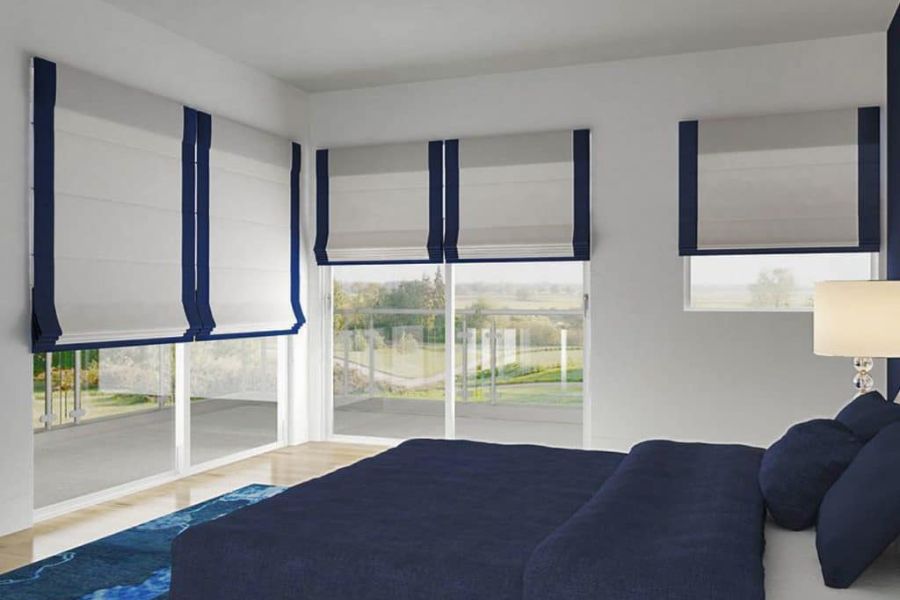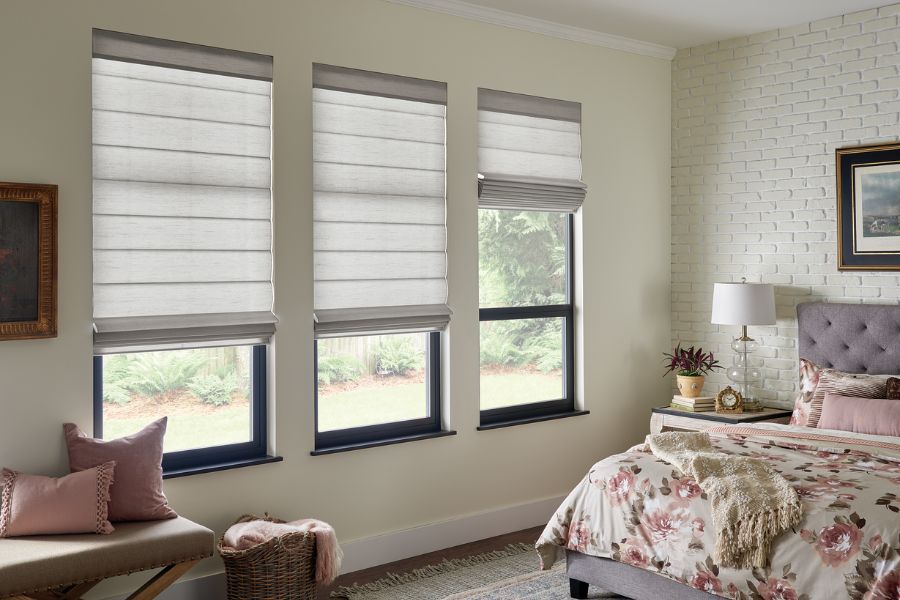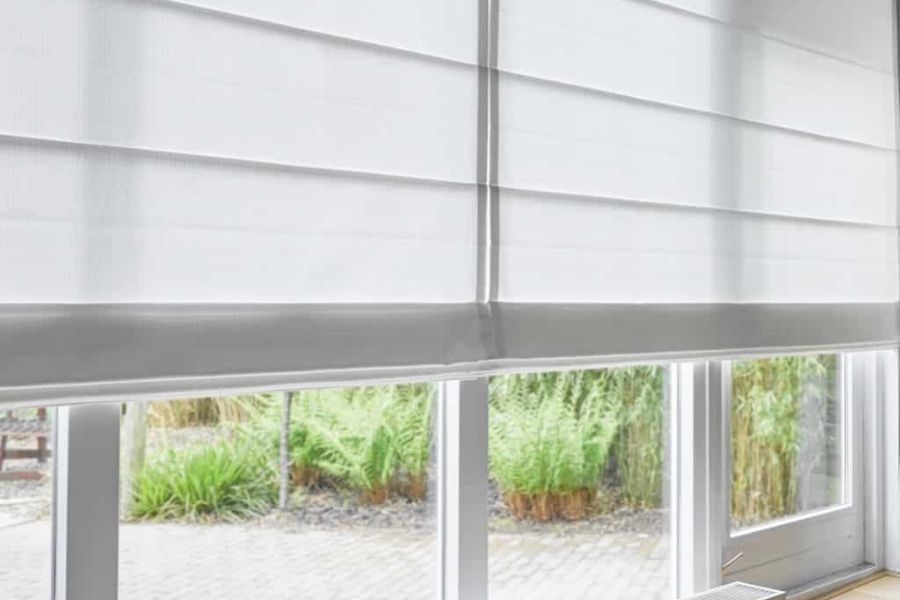Key Takeaways
- Read the full article to explore all 12 best type of blinds for living room and gain valuable insights on choosing and maintaining them.
- To choose the perfect blinds for your space, consider light control, privacy, style, material, maintenance, and budget. Find out the reasons right below!
- Our expert tips below will keep your blinds looking great and lasting longer.
12 Best Types of Blinds for Your Living Room
Roman Shades
Roman shades are a stylish way to elevate your living room decor. They consist of one fabric that folds into neat pleats when raised. This design adds a touch of sophistication to your windows and fits well with many living room styles, making it one of the best type of blinds for living room.
Roman shades include grasscloth, polyester, woven woods, cotton blends, and silk. Some fabrics may wrinkle initially, but these usually smooth out after a few days. They are customizable with different liners, from sheer for a soft effect to blackout liners that block all light. These options allow you to choose how much light and privacy you need.
Lighter fabrics create an airy ambiance in living rooms. For better privacy and sleep, heavier materials or blackout shades work well in bedrooms. For kitchens, choose moisture-resistant fabrics that handle splashes and cooking odors while balancing light and privacy. Roman shades are also great for commercial spaces, offering aesthetics and durability in high-traffic areas.
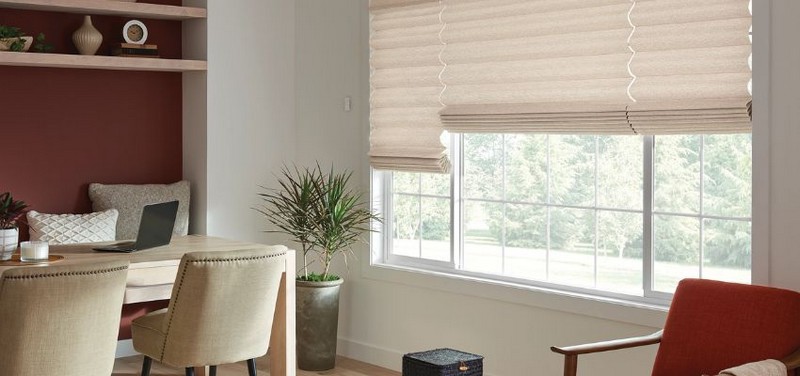
Shutters
Shutters are one of the best types of blinds for living rooms. They add elegance and architectural value, making them a great investment. Shutters have evolved from ancient marble versions to modern timber models, combining aesthetic charm with practical benefits.
These versatile window coverings offer precise light and privacy control with adjustable slats. Shutters are available in wood and faux wood and cater to various preferences and budgets. Their durability and timeless appeal make them popular worldwide.
Shutters are like premium furniture for your home, boasting the beauty of hardwood. They improve both interior aesthetics and exterior appeal. Additionally, shutters provide excellent sound absorption and enhance the overall look of any room.
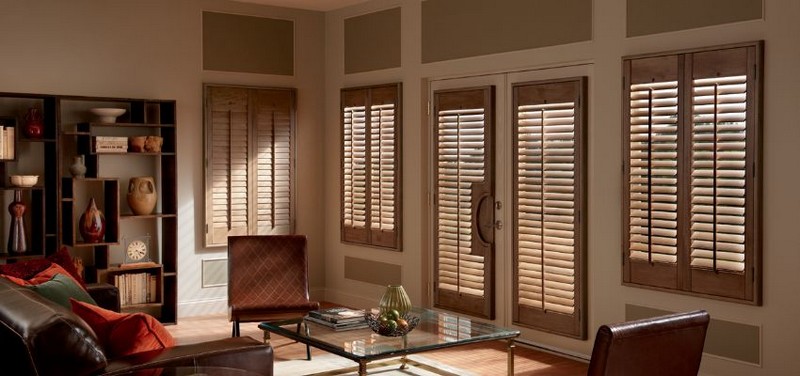
Cellular Shades
Cellular shades, or honeycomb shades, are among the best blinds for living room large windows due to their exceptional energy efficiency. Their honeycomb structure traps air, providing insulation and helping regulate room temperature, ensuring a comfortable living space that seamlessly blends with your decor.
These shades create a cozy atmosphere and reduce heating and cooling costs. They allow natural light to filter through, are durable, and are ideal for high-traffic areas. Cellular shades also reduce noise and add privacy, enhancing the living room experience.
You can choose single, double, and triple-cell options for different insulation levels. Materials like polyester, woven fabrics, cotton, and linen affect their look and feel. Light filtering options include sheer, light filtering, room darkening, and blackout, catering to various privacy needs. These blinds fit multiple window types and come in many colors and patterns to match any decor style.
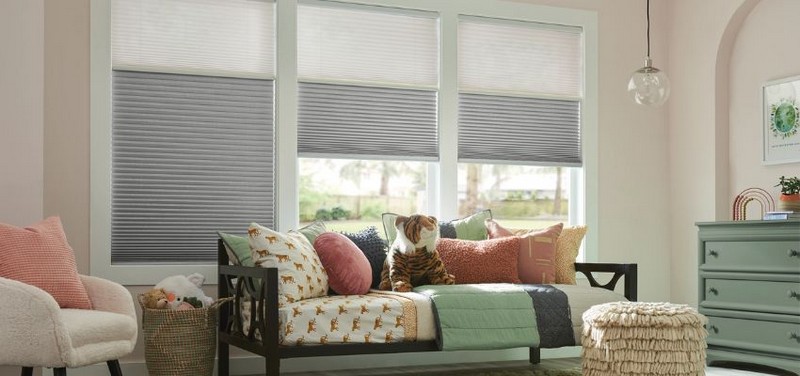
Drapery
While blinds offer functionality, drapery reigns supreme for living room window treatments. They elevate the space beyond simple light control, infusing it with elegance and style. Plush fabrics drape beautifully, framing windows and drawing the eye upwards, creating an illusion of a more spacious room.
The endless fabric choices allow you to tailor the look and feel to your living room’s design. Sheer fabrics welcome soft, diffused light, perfect for creating a breezy and airy atmosphere. For a more dramatic effect, opt for heavier, lined drapes that offer blackout capabilities and enhance the feeling of intimacy.
Drapery isn’t just about aesthetics; it also boasts functional benefits. The fabric acts as an extra layer of insulation, helping to regulate the temperature in your living room and keeping it cozy in winter and cooler in summer. This can contribute to energy savings throughout the year.
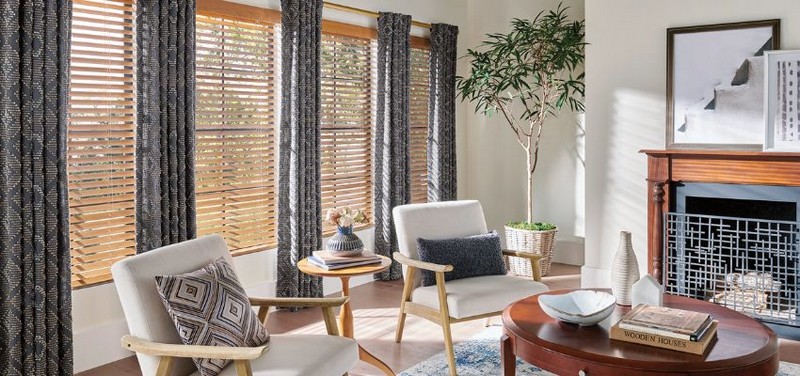
Venetian
Venetian blinds are one of the modern best types of blinds for living rooms. They have horizontal slats made from wood, aluminum, or plastic. These slats are easy to control using cords or fabric tapes. You can tilt them up to 180 degrees to adjust the light and privacy in your room. This makes them a great choice for living rooms where you want flexibility.
Venetian blinds originated in Persia and came to Europe in the 18th century. Their timeless style suits many interiors. They work well in kitchens, bedrooms, and offices, especially for narrow windows. Tilting the slats allows you to manage light, privacy, and room temperature. It is important to secure cords for safety, especially if you have children or pets.
Choosing the right material depends on your needs. Aluminum is good for bathrooms because it resists moisture. Wood adds a natural and elegant touch. Faux wood is durable and does not warp in humid conditions. Venetian blinds are affordable and easy to maintain. They control sunlight and enhance any room’s look, making them a practical choice for your home. Regular cleaning keeps them looking great and working well.
Faux Wood
Faux wood blinds, which resemble real wood while being more durable and resistant to moisture, are among the best blinds for living room windows. They offer a cost-effective and low-maintenance alternative to genuine wood blinds, making them suitable for various spaces.
Unlike real wood blinds that use natural materials such as cedar or pine, these blinds are crafted from composite materials like vinyl and PVC. They are available in various sizes, shapes, and colors, allowing you to find a perfect match for any interior design. Slat sizes typically vary from 1 to 2 ½ inches, ensuring compatibility with different window frames and complementing your room’s color palette.
Faux wood blinds provide excellent privacy, light control, insulation, and noise reduction benefits. They are robust, capable of withstanding humidity and sunlight, and maintain their appearance longer than real wood blinds. Options like cordless operation or motorization can enhance functionality, offering added convenience in daily use.
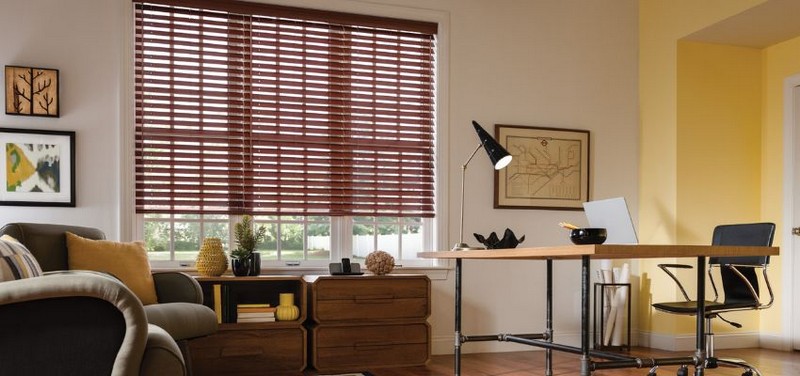
Roller Blinds
Roller blinds are a practical and stylish way to beautify your windows with shades in your living room. They are affordable, lightweight, and easy to customize, allowing you to choose fabrics, colors, and textures that match your decor.
Roller blinds offer different light blocking, privacy, and insulation options. Sheer fabrics let light in while maintaining privacy, which is great for street-facing rooms. Sunscreen fabrics protect from UV rays and keep your view while blocking outsiders.
If you prefer a home theater feel, room-darkening fabrics are ideal. Blockout blinds stop sunlight, improve insulation, and create a theater-like atmosphere. Double rollers offer versatility by combining different fabrics on one window. Automated roller blinds add convenience for adjusting light during a movie. Their contemporary, streamlined design makes them one of the best type of blinds for living room.
Blackout Blinds
Blackout blinds are considered among the best window blinds for living rooms due to their ability to block out light effectively. While traditionally associated with bedrooms, they offer benefits in other living spaces, including reducing screen glare during daytime TV or gaming sessions. This makes them ideal for creating a darker, more immersive environment for activities requiring focus, like gaming or watching movies on a high-quality TV with surround sound.
However, blackout blinds may not be ideal for daytime napping or casual lounging. They can lead to extended sleep durations by eliminating natural light cues that help regulate waking hours. In such cases, lighter options like dimout or light-filtering blinds are often more suitable. These blinds reduce glare while allowing natural light to enter, maintaining a comfortable atmosphere without complete darkness.
Moreover, blackout blinds are advantageous for video calls or content creation from the living room. They provide a controlled lighting environment and a neutral background for filming, enhancing visual clarity and professional presentation. Whether for enhancing home entertainment experiences or optimizing work-from-home setups, blackout blinds offer versatile solutions tailored to different living room needs.
Zebra Blinds
Zebra blinds, or dual blinds, offer a modern alternative to traditional horizontal blinds. They feature alternating opaque and sheer fabric stripes that seamlessly transition daily tonight.
These highly versatile blinds are considered among the best window blinds for living rooms. They are uniform, sleek, and suitable for any window size or shape. It is easy to maintain and space-efficient, so zebra blinds are popular due to their lightweight design and user-friendly operation.
One of their standout features is their ability to complement various window styles, enhancing the room’s visual appeal with a clean, streamlined look. By adjusting the position of the stripes, you can control the amount of light and privacy in your living space. Aligning the opaque stripes allows light to filter through the sheer ones while spacing out the opaque stripes enhances privacy and darkens the room.
Explore more: Blinds Vs Shades: What Is The Difference Between Them?
Vertical Blinds
Vertical blinds are highly suited for living rooms due to their horizontal vertical slats, offering effective control over sunlight in large spaces. They come in various textures and colors, though they are more commonly found in workplaces and larger rooms than typical living rooms.
Ideal for tall windows often found in living rooms, vertical blinds feature long louvers that tilt to deflect sunlight throughout the day. They can be adjusted using a control wand or retracted with a pull rod, making them convenient for rooms with garden access.
Vertical blinds offer practical benefits like thermal and blackout linings, allowing you to customize shading and add aesthetic flair to your windows. Their key advantage lies in the ability to tilt the slats, regulate light, and maintain privacy even when closed. This makes them suitable for balancing natural light and seclusion in bedrooms and living areas.
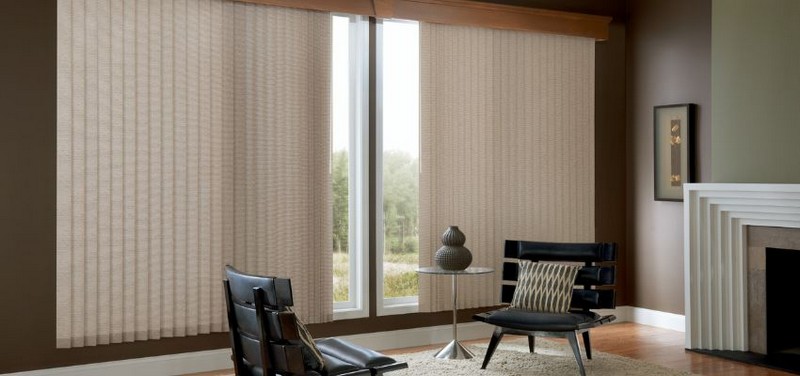
Smart Blinds
Smart blinds are a leading choice for the best type of blinds for living room, integrating advanced home automation technology. They allow homeowners to control their blinds via smartphone apps, providing seamless operation across multiple windows and even throughout the home. This capability is particularly beneficial when combined with other smart home features like home theaters.
Electric blinds are already popular in lounges because they allow users to adjust them from the comfort of their sofas. However, smart blinds take convenience a step further. Operable via smartphone apps or smart home devices such as Nest or Alexa, they offer remote management from anywhere.
You can schedule them to raise or lower at specific times, enhancing security when you’re away and ensuring a welcoming atmosphere upon your return or waking up in the morning. This versatility makes smart blinds a practical and innovative choice for modern living room settings.
You might want to know: Understanding Window Treatments: A Guide To Motorized Blinds.
Solar Blinds
Solar blinds function like sunglasses for windows. They feature tightly woven fabric that absorbs heat and blocks solar rays while maintaining an outside view. They are ideal for controlling indoor temperatures and safeguarding floors, furniture, and artwork in living rooms from sun damage.
These blinds are particularly beneficial in sunny spaces such as dens, sunrooms, or outdoor porches. They provide effective UV protection and varying levels of sunlight filtration, from light blocking to complete blackout options. This versatility allows you to enjoy natural light safely while maintaining a comfortable environment indoors.
Solar blinds enhance sunny rooms’ functionality by mitigating heat and glare without sacrificing visibility. Whether you prefer subtle light filtering or complete sun control, solar blinds offer a practical solution for enhancing comfort and protecting your living room’s interior from sun-related wear and tear.
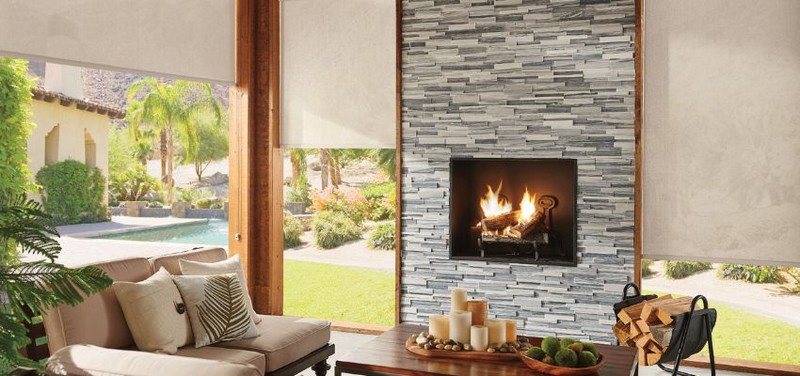
How to Decide The Best Type of Blinds for Your Living Room
The living room is the heart of the home, and the window treatments you choose can significantly impact its style, comfort, and functionality. But with so many options available, selecting the best type of blinds for living room can be overwhelming.
Here are some key factors to consider to make the perfect choice:
- Light Control: How much light do you want in your living room? Venetian blinds offer excellent control, while roller shades can provide complete blackout. With their honeycomb design, cellular shades offer a balance of light filtering and insulation.
- Privacy: Do you need complete privacy, or is some light filtering sufficient? Vertical blinds are a good choice for large windows and sliding doors, while real wood or faux wood blinds offer a classic look with adjustable privacy.
- Style: Consider your living room’s overall aesthetic. Roman shades add a soft touch, while plantation shutters elevate the space with a timeless elegance. Vertical blinds work well in modern settings, while Venetian blinds offer a classic and versatile option.
- Material: Blinds come in various materials, each with its advantages. Wood blinds offer a natural look but require more maintenance. Faux wood blinds are a budget-friendly option that’s durable and easy to clean. Aluminum blinds are moisture-resistant and ideal for kitchens or bathrooms, but they might not be the best choice for a living room.
- Maintenance: Consider how much time you spend cleaning your blinds. Fabric blinds may require occasional dusting or vacuuming, while aluminum or faux wood blinds are easier to clean.
- Budget: Window blinds are available at a range of prices. Consider your budget and prioritize the features that are most important to you.
Discover expert tips on “How To Choose The Perfect Blinds For Your Sunroom” and transform your space today!

Mix and Match Blinds: Expert Recommendations
While choosing a single-blind type is perfectly valid, exploring the world of mix-and-match window treatments can elevate your living room design. Here, experts share their recommendations for achieving a stylish and functional space:
- Blinds and Curtains: This classic combination offers the best of both worlds. Blinds provide excellent light and privacy control, while curtains add softness and texture. Choose roller blinds for a clean look paired with sheer curtains for a touch of diffused light. Alternatively, with their fabric folds, Roman blinds can create a cozy feel alongside heavier drapes.
- Contrasting Textures: Play with textures to add visual interest. Woven wood blinds, for example, introduce a natural element that complements flowing silk curtains. Vertical blinds with a subtle sheen can add a touch of modern luxury when paired with velvet drapes.
- Cohesive Palette: Keep colors in the same family to ensure a seamless look. If your living room boasts bold walls, opt for neutral-toned blinds and curtains in complementary shades. Conversely, with neutral walls, you can introduce pops of color with patterned curtains or brightly-hued blinds.
- Light Control: Consider the amount of sunlight your living room receives. If you crave maximum light control, blackout roller blinds and sheer curtains offer the perfect balance. Roman blinds with a light fabric can be layered with linen curtains for a more diffused light effect.
Seeking insulation and light filtering? Explore our Lake House Project: Blinds & Motorized OpenLight Roller Shades for advanced solutions that enhance comfort.
Expert Tips on Maintenance and Durability
Maintaining blinds is crucial for a clean and polished living space. Experts recommend quick dusting sessions weekly to keep blinds spotless. While they hang, use a microfiber tool or a vacuum with a soft brush attachment to clean them. This method is efficient for natural wood, fabric blinds, and cellular shades.
Use the bathtub method when deeper cleaning is necessary, especially for metal, vinyl, or faux wood blinds. Always line the tub with towels to prevent scratches and avoid soaking real wood or cellular shades. For the best cleaning results and longevity of your blinds, refer to the manufacturer’s instructions and avoid using water on wood blinds.
For more detailed cleaning methods, visit the Efficient Methods For The Best Way To Clean Blinds. To choose the right blinds and get expert cleaning and maintenance tips, contact the specialists at Creative Windows for support and a free consultation.


